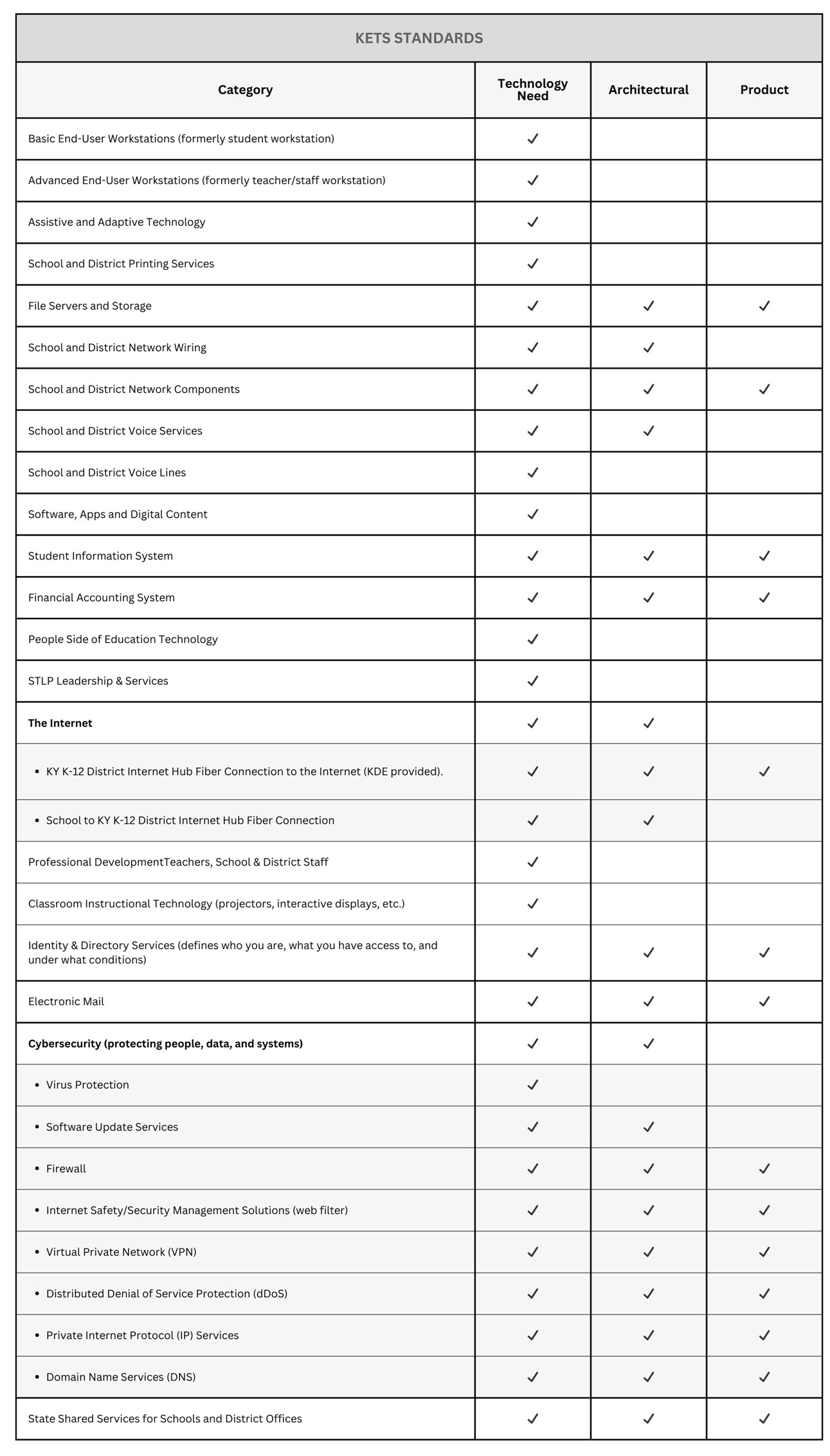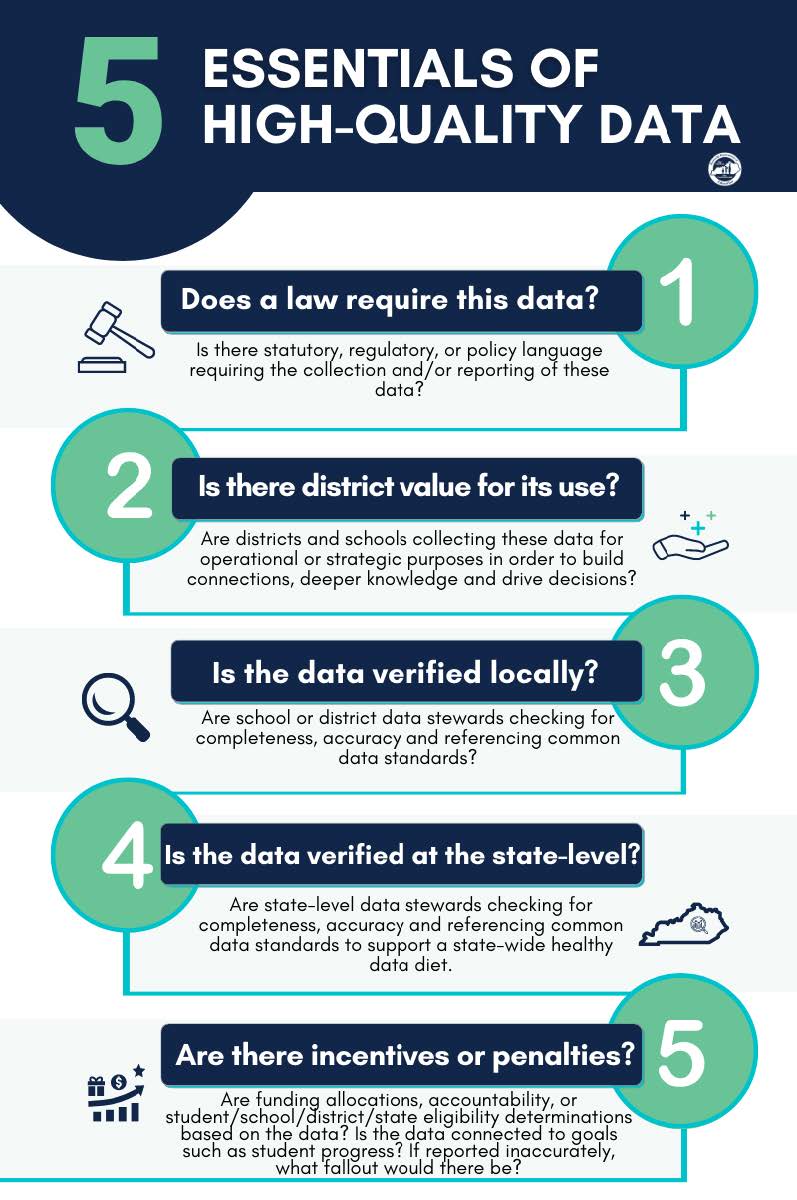Appendix E - KETS Standards and Establishing Technology Need
Enterprise Standards
From the inception of the Kentucky Education Technology System, the existence of standards has provided Kentucky with "the edge" over all other states. Standards represent a uniform set of specifications and guidelines that are leveraged to ensure system interoperability and reduce operational complexity, therefore reducing the overall Total Cost of Ownership. Our approach is an enterprise design in which all districts are working toward common objectives. Kentucky is committed to the guiding principle of viewing technology investments from an enterprise perspective. The Enterprise Architecture and subsequent standards represent the overall plan and a living process for designing and implementing education technology (EdTech) solutions to serve both instructional and administrative functions.
An information technology architecture and related set of standards are vital to ensure the compatibility of the current education technology projects and future education technology initiatives. The Enterprise Standards are important for defining the rules by which technology is envisioned, implemented, and managed.
Since 1992, enterprise standards have anchored all instructional, administrative, and technical aspects of Education Technology. These standards have afforded the state a) significant savings in the initial procurement of technology equipment, b) equitable supportability regardless of geographic location, c) a foundational infrastructure to provide for secure, global ease of access, d) statewide collaboration via various forms of electronic mediums (email, telephonic, video-conferencing), e) statewide adoption of the Internet as an instructional resource, and f) uniform education technology applications to address both student management and financial management. All Commonwealth of Kentucky public school districts share in the benefit of each of these efficiencies due to a common set of standards. Standards minimize the retraining required when staff moves between schools or districts and lessen the annual support required after implementation. In a Kentucky K-12 study, the Gartner Group noted the enterprise standards approach saves Kentucky millions of dollars annually. The KETS enterprise standards are formalized into three different categories of standards: Technology Needs Standards, Architectural Standards, and Product Standards, with the first two (technology need standards and architectural standards), commonly referred to as “technical standards."
Technology Need Standards represent the equitable baseline of all technology components required to adequately address both the education technology instructional and administrative needs of K-12 and involve the following two separate but complementary criteria.
- Component ratios (quantities) – Expectation that all districts maintain minimum ratios, based on average daily attendance, total number of schools, total number of teachers or total number of classrooms, for each technology component to effectively address equity and ease of access for all instructional and administrative activities.
- Component refresh cycle (years) – Replacement of components on a scheduled basis over time, in accordance with the useful life cycle of each item or service.
Architectural Standards (sometimes referred to as Technical Standards) are vendor-neutral Information technology specifications and guidelines that define system interoperability into the KETS enterprise. These are in place to enforce supportability, cost-effectiveness, security, usability, availability, and accessibility.
The following
13 Architectural Design Principles underlie the Architectural and Product standards and are used to guide KETS solution design by helping ensure that KETS is "doing the work right." They serve as standard requirements and are considered in combination with the specific functional requirements of each project. Any given solution may not fully meet one or more of these principles. However, if that is the case, there should be solid rationale and explicit understanding prior to moving forward with the design or solution.
- Equitable – Solutions should provide equal value and benefit to schools and districts regardless of local budgets, existing equipment and software, geographical location, or organization size.
- Always On, Anywhere, Anytime, Any Device – Solutions should be available and supported 24/7, accessible from a wide range of devices, and accessible from any physical location.
- Supportable – Solutions should use equipment, software, and services that are efficiently supportable and manageable by both KETS staff and the responsible vendors.
- Learning First – Solutions should prioritize instructional and learning needs above administrative needs.
- Partners Involved – Solutions should maximize partner accountability by making all possible use of partner capabilities for development, infrastructure, ongoing operations, and support.
- Education Driven – Solutions should cost-effectively meet a well-defined educational/programmatic/administrative need of school districts and/or KDE.
- Up-to-date: Solutions should use leading-edge technologies and offerings.
- Measurable: Solutions should provide easy-to-use mechanisms to report on system usage.
- Integrated – Solutions should integrate with existing KETS infrastructure while aligning with KETS strategy for the future.
- Usable – Solutions should be easy, efficient, and pleasant to use for their target user populations.
- Secure – Solutions should protect confidential data, their own integrity, and the KETS environment against accidental or malicious damage.
- Cloud – Solutions should be based on cloud offerings (ideally SaaS).
- Extensible: Solutions should allow tailoring for unique per-district requirements.
Kentucky K-12's education technology product and design standards are "the" big edge that Kentucky K-12 has over the other 49 states and a big reason KETS is viewed as a national leader in education technology. Kentucky K-12 is the national leader in having education technology products and design standards/policies for all our schools, districts, and the Kentucky Department of Education (KDE) program areas. This allows Kentucky K-12 to (1) significantly reduce costs, (2) provide equity of price and service to all districts, (3) make all the technology-enabled components work reliably together on a large scale with smaller EdTech staffs, (4) quickly integrate different large EdTech systems together and (5) provide great cyber security.
Product Standards provide the purest alignment and maximizing of efficiencies within KETS when KETS product components are utilized. These technology components embody architectural design/configuration specifications established by the award of a KETS vendor contract that resulted from a formal bid request issued by open, competitive solicitation or a request for proposal (RFP). Contracts are awarded in accordance with the Kentucky Model Procurement Code through the Kentucky Finance and Administration Cabinet, Office of Procurement Services. These contracts are intended to provide the most impressive levels of interoperability, minimal support complexity, and the most conservative total cost of ownership across K-12. In addition, the purchasing power of the state is maximized by leveraging the weight of the entire organization to buy a product standard. Specific technology (hardware or software) deemed by either the KDE or Commonwealth Office of Technology as an enterprise component made available via a statewide procurement vehicle (state or KETS contract) are considered KETS and/or State Product Standards.
Any technology procured or secured by a district, in a category for which a KETS technology need standard is established, regardless of whether the item is used to reduce the technology need or not, must meet or exceed the KETS standard in compliance with 701 KAR 5:110 and must be reflected in statewide reporting (through the Technology Activity Report and Digital Readiness Collection).
The following technology will not be used to reduce the technology need of the district for calculating the amount of offers of assistance for which the district is eligible.
- secured through a local initiative that is not procured with public revenues
- procured with federal categorical funds
The following table lists KETS Standards categories and those that are further defined with Technology Need, Architectural, and/or Product Standards.

Accessible version of the KETS Standard Chart
Data Standards help districts and the KDE to ensure data is consistently entered statewide and allow accurate responses to various reporting requirements and the sharing of data between systems. Specific data elements must be collected to ensure that information is available for federal and state reporting and other data sharing. KDE has established standards for various categories of data, including many collected through the
Kentucky Student Information System and the District Financial System (MUNIS). Additionally, Figure E1 calls out the five essentials of having and using high-quality data that KDE continues to work on with partners and stakeholders. These essentials also help push on the understanding of the specific data elements that can be expected to be accurate and complete, as well as the data elements that have lower expectations (of being accurate and complete).

Contents
- Appendix D <
Appendix E >
Appendix F